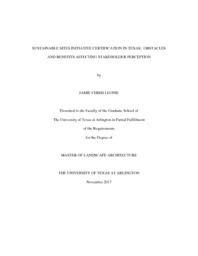
ATTENTION: The works hosted here are being migrated to a new repository that will consolidate resources, improve discoverability, and better show UTA's research impact on the global community. We will update authors as the migration progresses. Please see MavMatrix for more information.
Show simple item record
| dc.contributor.advisor | Hopman, David | |
| dc.creator | Leonie, Jamie Chism | |
| dc.date.accessioned | 2023-09-11T15:01:22Z | |
| dc.date.available | 2023-09-11T15:01:22Z | |
| dc.date.created | 2018-05 | |
| dc.date.submitted | May 2018 | |
| dc.identifier.uri | http://hdl.handle.net/10106/31675 | |
| dc.description.abstract | The purpose of this research is to examine perceptions of key stakeholders involved in three SITES®-certified pilot projects in Texas to determine the obstacles and benefits they experienced in certifying the projects. The Sustainable Sites Initiative (SITES®) is a sustainability-focused framework that guides landscape architects, engineers and others toward practices that protect ecosystems and enhance the mosaic of benefits they continuously provide our communities, such as climate regulation, carbon storage and flood mitigation. SITES® is the culmination of years of research and development by leading professionals in the fields of soil, water, vegetation, materials and human health (GBCI, 2017). A SITES® certification marks a project’s commitment to sustainability.
This research examined the methods used by landscape architecture professionals, land owners, community developers, municipalities and other stakeholders in earning a SITES® certification by assessing the opinions of a group of key informants who were responsible for the certification of each of the SITES® projects below. In addition to their opinions about the financial investment and the time/expertise necessary to apply for and receive the certification, the stakeholders were interviewed to determine their impressions of each project, the complications they encountered in the certification process, and their recommendations for certification of future projects.
SITES® can be applied to any landscape project, anywhere in the world, on sites with or without buildings. To represent a cross-section, the three SITES® certified projects for this study represent a variety of project types. The projects studied are listed below:
1. Blue Hole Regional Park—Wimberley, TX: An open space park owned and operated by a municipality.
2. Perot Museum of Nature and Science – Dallas, TX: A civic/institutional project located in an urban setting.
3. The Green at College Park– Arlington, TX: An education/institutional project located on a university campus.
The research used qualitative research methods which included in-depth telephone and face-to-face interviews (Taylor and Bogdan, 1984). By studying recordings of the interviews and other printed and verbal material, themes were identified and used to evaluate the SITES® certification from the perspective of the key informants studied. Thoughts and ideas shared by the participants during the interviews informed the collection and distillation of user/participant value. The results and implications of this evaluation are discussed within the study.
This research tests the SITES® v2 rating system, currently in use against the comments received from pilot projects using SITES® Guidelines and Performance Benchmarks in Texas. This study documents challenges the pilot projects encountered when following the prerequisites and credits needed for SITES® certification, and how SITES® v2 responded. | |
| dc.format.mimetype | application/pdf | |
| dc.language.iso | en_US | |
| dc.subject | SITES® | |
| dc.subject | Sustainable Sites Initiative | |
| dc.subject | Pilot Projects | |
| dc.subject | Landscape Architecture | |
| dc.subject | Sustainability | |
| dc.subject | SITES® Guidelines and Performance Benchmarks | |
| dc.subject | The Blue Hole Regional Park | |
| dc.subject | The Green at College Park | |
| dc.subject | The Perot Museum of Nature and Science | |
| dc.title | SUSTAINABLE SITES INITIATIVE CERTIFICATION IN TEXAS: OBSTACLES AND BENEFITS AFFECTING STAKEHOLDER PERCEPTION | |
| dc.type | Thesis | |
| dc.date.updated | 2023-09-11T15:01:22Z | |
| thesis.degree.department | Landscape Architecture | |
| thesis.degree.grantor | The University of Texas at Arlington | |
| thesis.degree.level | Masters | |
| thesis.degree.name | Master of Landscape Architecture | |
| dc.type.material | text | |
| dc.creator.orcid | 0000-0003-2160-7517 | |
Files in this item
- Name:
- LEONIE-THESIS-2018.pdf
- Size:
- 8.216Mb
- Format:
- PDF
This item appears in the following Collection(s)
Show simple item record


